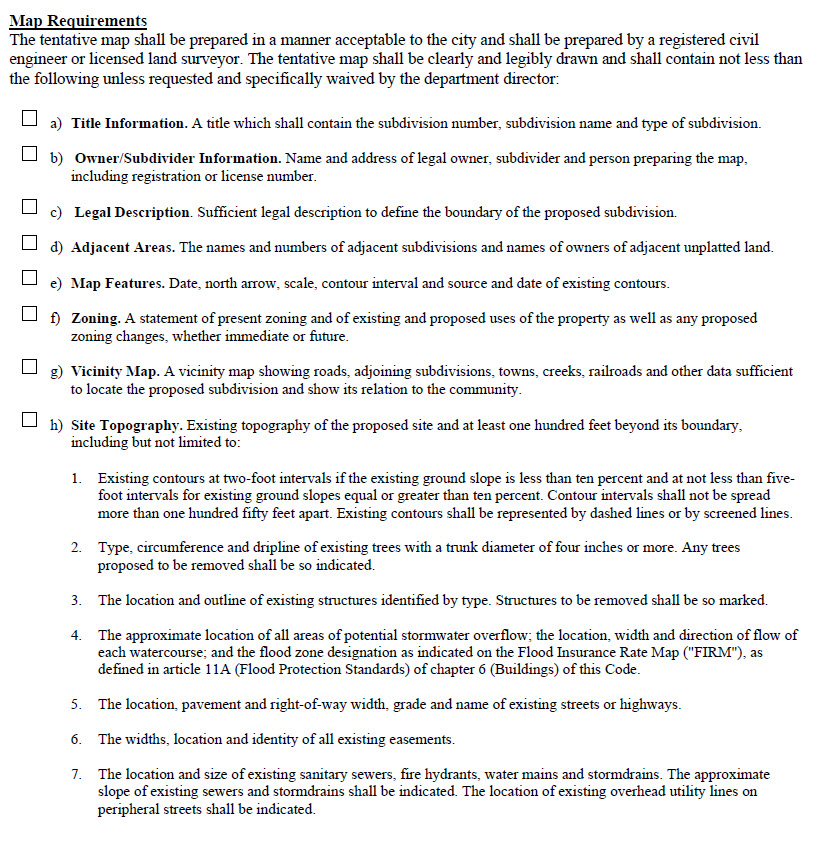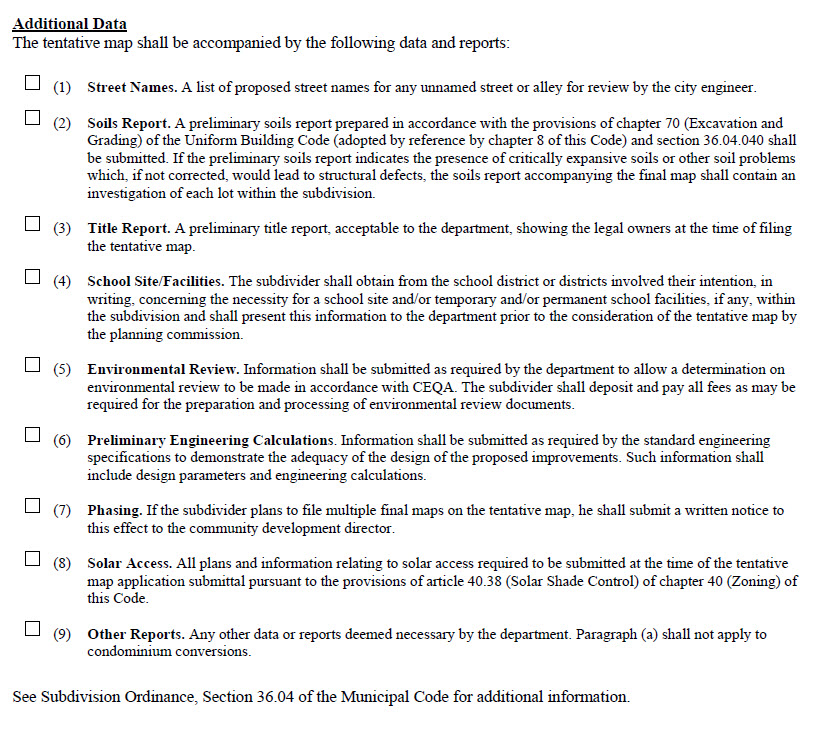
Last week in presenting the plan for the West Davis Active Adult Community, Dave Taormino told the Vanguard that a Measure R vote does not require the specificity of a tentative map in order to be approved by the voters.
However, there was a lot of pushback from readers on the idea of not including a tentative map prior to the vote.
The question the Vanguard has asked is what the tentative map contains that would not be included in the project baseline features, which are required under Measure R and cannot be changed without a subsequent vote.
In an effort to help the Vanguard readership better understand their thinking, Dave Taormino has asked the Vanguard to publish the tentative map checklist for the city of Davis, so that the readers “can judge for themselves as to the value in knowing this type of information and how these details would influence their vote.”
He told the Vanguard, “Some of the items called for in it will be important and will be part of the baseline features along with our site plan.”
He added, “Our application along with the baseline features and amenities is much more instructive than the tentative map, which items are technical and almost always engineering related.”
Here they are:



Now, having read the tentative map checklist, what do you think? Which items should be included in the project baseline features and which items do you think can be resolved after a vote?
Most important for the purpose of this discussion – please explain your reasoning.






Caveat… the checklist shown is not fully reflective of the ordinance, (but very close); and the Chapter 36 of the Muni Code governs; much of the ordinance reflects State law (Govt Code Sections 66410, et seq.)… in case of conflict, State law governs… the muni code goes into more detail than the state law, but that, in itself, is not a conflict…
See, http://qcode.us/codes/davis/ (chapter 36, Subdivisions)
The checklist also contains some xref’s to the zoning Code… ex. Solar Access is truly not a requirement of the TM, as it is actually required in the zoning code. It is reiterated elsewhere as an aid to applicants and staff.
This should be fun…
The check list comes directly from the city of Davis, for what it’s worth.
Yes, I know… intimately. I also know the last time it was ‘updated’… as I said, it is very close, but wanted to put the caveat out that it isn’t ‘perfect’… was trying to divert folk from minutiae…
It is indeed what staff uses, and key staff also know nuances beyond what the checklist specifically says.
BTW, David, thanks for posting it… I couldn’t find it on the website, otherwise would have shared a link to it as part of the earlier discussion…
Howard: I figured you knew, but just wanted to make sure people reading understood.
Always good when folk understand… as I said, thanks for putting it out there, and I recognize it as authentic.
Mr T is correct in that many of the key requirements need to be reflected in GP, zoning entitlements, DA, ‘baseline features’, etc. before a TM is deemed complete for processing… there are also some ‘implicit’ baseline features… like complying with State Law and all local ordinances… those are so “baseline”…
Just a hunch, but I think the insistence on having the developer provide the tentative map is only a delaying or raising the bar tactic by those who oppose most any developement in the hopes that the developer will give up and abandon the proposal. There hasn’t been any substantive argument in favor of the developer providing it, only the “That’s the way it’s always been done before.” argument.
These are possibly implicit in Additional Data, items 2 and 5, but just to be explicit: there should be information about soil quality from an agricultural point of view, and there should be information about ag mitigation and ag buffers. And a clear distinction between “green areas” and “open space.”
Also information about local habitat and species of concern, if any, and mitigations for those.
Those need to studied/addressed/discussed in the EIR, and addressed in the conditions of approval for the pre-zoning (needed for annexation), and to the extent appropriate, in the DA… all before the Measure R/J vote.
The items you are concerned about are “ships have sailed” things as to how a TM can be conditioned… yet, the RESULTS of all those are required to be submitted at time of TM submittal, and are a “baseline”, if you will for the review of a TM.
Good points as to importance… but that’s not what items 2 & 5 are about in the Muni code and checklist…
As to item 2, the soils reports clearly are to the suitability as to building foundation designs… nothing more, nothing less. Does not address the issues you raise.
Item 5 really only applies absent other CEQA review… in the case at hand, an EIR will be required independent of a TM. The TM will need to take the EIR info, particularly mitigations, into account as part of the review of the TM.
Of course you cannot rely on a word I say, as I post semi-anonymously, so have no credibility, as you have pointed out before.
To the extent you can believe (or not) what I say, hope that helps…
So, in other words, “yes,” the items I mentioned should available before a Measure R vote. I wasn’t really seeking your approval or your help, but glad that you agree.
Key takeaway, given the topic, is that a TM is irrelevant to Measure J/R.
And was glad I was completely unneeded/useless… any time I can serve those functions, am avail….
BTW, since you asked no questions, “yes” would have been flippant, so did not do so.
Careful, Howard, you don’t want to be flippant anyone off.
Point taken, and accepted (with a grin) Paul.
I’d really like to hear from some of those people who weighed in last week that we need the tentative map.